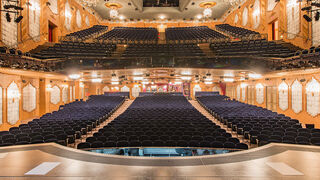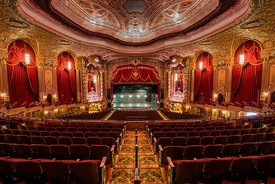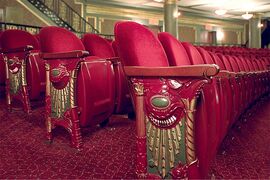Challenges & Solutions For Restoring Historical Theaters
By Anne Chapman
October 29, 2020

In 1998, Irwin Seating purchased a subsidiary that specialized in restorations. Experienced and dedicated project managers and restorers came with them, sharing what they knew about this task. By incorporating their knowledge and experience, we’re able to provide seat restoration to help historical theaters manage costs and requirements while preserving the look and feel of their theaters, for a better experience for all their guests.
Irwin is one of the few companies that owners of older theaters can rely on to provide expert work in-house to bring their historic theaters back to life. Where some companies outsource functions like painting, wood finishing, and upholstery, we do majority of work in our well-equipped facility in Grand Rapids, Michigan. Over the years, we have become familiar with the most common challenges in restoration, as well as the best solutions.
Staying up to Date with Building Codes
Older buildings often don’t meet today’s building codes in one way or another. Rows may have inadequate legroom, or aisles may be too narrow for current code. Often, a restorer will have to eliminate some chairs in each row, and move some rows to allow for larger, more comfortable chairs, and to conform to NFPA fire codes. While this process can be a bit of a puzzle at first, it will make the venue more comfortable for patrons and safer in the event of an emergency.
Providing ADA Compliant Seating
A full restoration and upgrade may mean making changes to conform to today's ADA accessibility requirements. Examples include adding handicap accessible chairs, accessible ramps, and features like swing up arms on chairs. We can help theater owners fix issues to make their facilities accessible to all.
In some cases, it is not financially feasible to fully rebuild a theater. In these cases, a theater owner may see what can be grandfathered in under older requirements. Sometimes, chairs may be restored instead of replaced because a complete replacement may require an expensive upgrade. By keeping the historic chairs, the facility can be grandfathered in. Theater owners will often need to work with local fire marshals and other officials to ensure that their projects can be grandfathered in.
Keeping Guests Comfortable
Some older seats have designs or issues that are not up to the comfort standards that today's guests expect. For instance, a number of old theater chairs have no padding at all, which modern audiences would not find acceptable for extended sitting. Many were made with older technology, such as springs in chairs, which are no longer used because better options exist. Upgraded materials can make for a better theater experience.
Preserving Historic Character
Some chair components, like those made of iron, can be restored over and over again. We've seen many that have been restored at least once before, and that we will someday fully restore again. Others cannot be restored to a quality level that will . At Irwin, our experience helps us recognize which chairs are good candidates for refurbishing and which ones should be replaced. For instance, a sample chair was sent from a historic theater in California. When our engineers evaluated it, we sadly came to the conclusion that there was a great deal of risk involved in restoring these chairs. When things like this happen, we work to present alternatives that will keep the look and feel of the theater, while offering more comfortable, durable options. In some cases, customers will opt for restoring the ends to keep the look of the theater the same, but will replace the seats with modern, wider ones.
Historic seating often has significance to the community. When we helped with the restoration of the Florida Theater in Jacksonville, we installed 2000 new chairs. However, local ghost stories gave some of the balcony seating local fame and significance. We helped the theater keep these noteworthy balcony seats in the facility by restoring them.


Our process has been finely honed over time. We work with local artisans to have metal and wood parts carefully stripped, then bring the items back here to be powder coated and refinished. Our upholstery is done in-house, and we can add custom details. Our in-house decorators can hand paint details such as Art Deco style embellishments to return them to their former opulence.
Brooks Atkinson Theatre with steel aisle end standards that have been powder coated as a base and hand decorated with gold details
Keeping Costs In Line and Dealing with Downtime
Theaters that get funding from organizations like the League of Historic American Theaters may need to preserve all features in order to maintain funding. We can help them fulfill those requirements while providing a better experience for the theater's guests.
In some cases, restoring a chair may cost more than having new ones made and installed. When it appears that will be the case, we work with owners to find satisfactory replacements.
A quality restoration process takes time. On average, we will have chairs in our facility for about 30 days when we are renovating them for a client; one of the best turnaround times in our industry. Most theater owners make plans for other projects during the downtime.
The King's Theater in Brooklyn, New York was abandoned before new owners decided to fully restore the theater. We helped them bring their well-worn seatsack to their former luster. Painted details were done by hand to preserve the unique look. Check out this brief interview with ACE Theatrical Group President, David Anderson, who lead the restoration to see this amazing transformation (Source: Associated Press).
Being a part of bringing a worn and sometimes decrepit building back is a small part of our work, but a rewarding one! We are proud to provide seating that matches the hard work put in elsewhere to make these historic places new again for the next generation of guests.